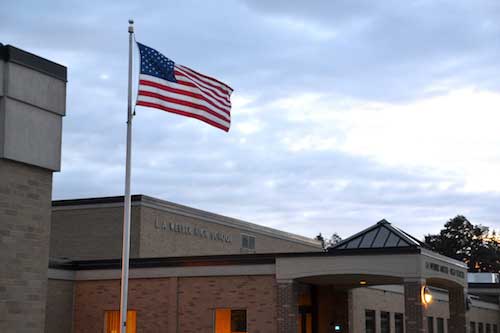Most Orleans districts see gains in graduation rate

Photo by Tom Rivers: Lyndonville high school students have the highest graduation rate in Orleans County at 97 percent.
The graduation rates in Orleans County improved from 87 to 89 percent, according to data released on Wednesday by the State Education Department.
Lyndonville has the highest graduation rate at 97 percent for the Class of 2017 while Medina is the lowest at 84 percent.
State-wide, the graduation rate was 80.2 percent of the students in the Class of 2017. These are students who entered high school as freshmen in 2013 and completed the necessary coursework to graduate four years later. That was up by 0.5 percent from the 79.7 percent of students who entered high in 2012 and had four years to graduate with the Class of 2016.
In Orleans, the graduation rate improved to 89 percent. The percentage of students graduating with a Regents diploma with an advanced designation also increased from 28 percent to 36 percent. (Regents with advanced designation means at least 22 units of credit at 65 percent or higher in comprehensive English, three math courses, global history, U.S. history, science and a language other than English.)
The percentage of students who graduated with a Regents diploma decreased from 54 to 49 percent. (Keep in mind there was an increase in students attaining Regents with advanced designation.)
Other facts about Orleans students include:
• The percentage of graduates with a local diploma went from 5 to 4 percent.
• The dropout rate increased from 5 percent (24 out of 514 students) to 6 percent (26 out of 468).
• The number students in the cohort dropped from 514 in 2016 to 468
• Girls have a 90 percent graduation rate compared to boys at 88 percent for 2017.
• White students graduated at a 90 percent rate in 2017, while black students were at 84 percent and Hispanic students at 86 percent.
• Students who weren’t economically disadvantaged (223 out of the 468 students) graduated at a 93 percent rate while students considered economically disadvantaged (194 out of 468) graduated at an 85 percent rate.
A snapshot from each district in Orleans includes:
• Albion – Graduation rate stayed at 88 percent from 2016 (156 students) to 2017 (126 students). However, the percentage of students earning Regents with advanced designation increased from 38 to 45 percent. The percentage receiving Regents with distinction or Regents stayed at 85 percent, while the percentage of dropouts increased from 6 to 7 percent, or 9 students for both cohorts.
• Holley – Graduation rate increased from 89 percent in 2016 (93 students) to 91 percent (94 students in 2017). The percentage of students earning Regents with advanced designation increased from 22 to 24 percent, and Regents advanced and Regents is up from 80 to 84 percent. Holley’s dropout rate decreased from 5 to 2 percent.
• Kendall – The graduation rate decreased from 94 percent (71 students in 2016) to 90 percent (59 students in 2017). The percentage earning Regents with advanced designation increased from 35 to 41 percent. Students with Regents or Regents advanced dropped from 89 to 87 percent. The percentage of dropouts increased from 1 percent (1 students in 2016) to 5 percent (3 students in the 2017 cohort).
• Lyndonville – The graduation rate increased from 93 (44 students in 2016 cohort) to 97 percent (64 in 2017). The percentage earning Regents with advanced designation was up from 23 to 36 percent, and students with Regents or Regents advanced increased from 87 percent in 2016 to 95 percent. Lyndonville had two dropouts (5 percent) in 2016, compared to one dropout or 2 percent in 2017.
• Medina – Medina made progress with the 2017 cohort, increasing the graduation rate from 79 percent (150 students in 2016) to 84 percent (125 students with 2017 cohort). The percentage of grads attaining Regents with advanced designation jumped from 21 percent to 34 percent. The combined percentage of grads earning Regents and Regents advanced increased from 77 to 80 percent. The dropout rate increased from 5 percent (7 out of 150) to 9 percent (11 out of 125).





































































